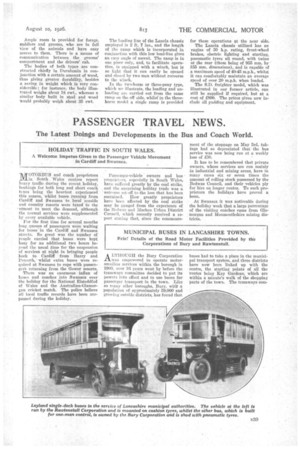FURTHER DESIGNS OF MOTOR HORSEBOX.
Page 22

Page 23

If you've noticed an error in this article please click here to report it so we can fix it.
Some Details of Metcalfesi Model on the Reo-Pullman Chassis and the Curtis Horsebox on the Lancia Chassis.
FOLLOWING our recent article entitled "Transporting Valuable Horses by Road," which we published in our issue dated July 27th, we have received information regarding several other interesting types of horsebox which deserve special mention.
The first of these is built by Metcalfes, 189, Regent Street, London, W.1, whose works are at Romford. It is designed to carry two horses with their grooms and equipment, and is mounted on the Reo-Pullman low-load-line chassis, other features of which include a long wheelbase, a six-cylindered power unit, and certain other refinements which make sit a chassis eminently suitable for this class of work.
The body is so designed as to carry the herses,forward of the rear wheels, and the animals face to the back. Mangers are fitted over the wheel arches, whilst the seats for the grooms are at the extreme end of the vehicle in a position conveniently close to the horses' • heads; a bar at the rear permits access to this portion of the body.
The horses enter and leave by way of a large ramp at the near side, this ramp having a width of 8 ft 6 ins, and a length of 6 ft. 6 ins. It is built in one piece and forms a portion of the aide of the vehicle, whilst a springcontrolled gear permits safe and speedy lowering and lifting. When lowered it gives a comfortable incline from the ground to the floor level, which is 2 ft. 6 ins. high. Side wings are employed to obviate the risk of horses slipping or jumping off. The horses are separated from each other by means of a centre partition which easily opens oat to give access to the animal on the off side. This partition, together with the interior, is well upholstered in white canvas stuffed with hair ; coconut matting is provided at the lower portions and on the floor of the • ramp. The roof gives a clear 7 ft. headroom, but is upholstered above the heads of the horses as an additional precaution. Ample ventilation is provided for by louvres in the sides and other ventilators in the roof, and adjustable hinged entries for air are also provided at the forward end.
The interior equipment includes electric lighting and a communication bell in the driver's compartment which is operated from that of the grooms. The windows are made to open and are protected by iron grids ; they are positioned at the rear and sides, but, of course, not in the part reserved for the horses.
To meet a much-felt need, the Livestock and General Utility Vehicle Co., Ltd., 18, Berkeley Street, London, W.1, have designed a new box to carry three horses of full size and yet remain within the regulation width, each horse having its full 2 ft. 6 ins, clear between the padding. At the moment illustrations of this new type are not available, but the first example will be on the road in about a fortnight's time. It will be priced at 1900 on the Lancia-Pentaiota chassis. 'A lesser number of either horses or ponies can, of course, be carried in this machine if required, and all the interior fittings, padding, etc., are demountable, so that the vehicle can be arranged for carrying farm produce, etc.
The company also build a two-horse or three-pony-type box similar to that illustrated, but mounted on the LanciaPentaiota chassis. Complete, this costa 1865, and, like the other one just described, has a padded breast bar or breast straps.
Ample room is provided for forage, saddlers and grooms, who are in full view of the animals and have easy access to them. There is a menus of communication between the grooms' compartment and the drivers' cab.
The bodies of both types are constructed chiefly in Duralumin in conjunction with a certain amount of wood, thus giving greater durability, besides a saving in weight which is very considerable: for instance, the body illustrated weighs about 18 cwt., 'whereas a similar body built in steel and wood would probably weigh about 35 cwt.
The loading line of the Lancia chassis employed is 2 ft. 7 ins., and the length of the ramp which is incorporated in conjunction with this low load-line gives an easy angle of ascent. The ramp is in one piece only, and, to facilitate operation, is equipped with a winch, but is so light that it can easily be opened and closed by two men without recourse to the winch.
In the two-horse or three-pony type, which we illustrate, the loading and unloading are carried out from the same ramp on the off side, whilst in the threehorse model a single ramp is provided for these operations at the near side.
The Lancia chassis utilized has an engine of 30 h.p. rating, front-wheel brakes, electric lighting and starting, pneumatic tyres all round, with twins at the rear (these being of 955 mm. by 155 mm. dimensions), and is capable of a maximum speed of 40-411 m.p.h., whilst it can comfortably maintain an average speed of over 20 m.p.h. when loaded.
The S.D. freighter model, which was illustrated in our former article, can still be supplied if required, but at a cost of £800. The prices given now include all padding and equipment.




























